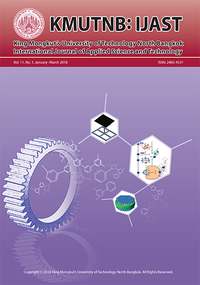Low Frequency Noise Reduction with Active Noise Control in Laboratory Settings
Main Article Content
Abstract
Noise problem becomes a major concern for public health throughout the world. This research is conducted to investigate how to reduce low-frequency noise in laboratory settings using Active Noise Control (ANC) technique. Experiments are performed under two conditions: 1) in a close room (6.7 m wide, 11 m long, and 2.87 m high), and 2) in an open field (8.2 m wide and 18 m long). Low-frequency noise at 200 Hz is generated by the 1,000 W speaker (as noise source), and the 1,200 W speaker is used as noise cancelling speaker. Error microphone and spectrum analyzer are installed for measuring noises. Findings indicate that noise reductions of 14.38 dB and 10.73 dB can be made in a close room and in an open field, respectively. Applications and limitations for this research are also discussed.
Article Details
References
[2] P. Tassi, O. Rohmer, S. Schimchowitsch, A. Eschenlauer, A. Bonnefond, F. Margiocchi, F. Poisson, and A. Muzet, “Living alongside railway tracks: Long-term effects of nocturnal noise on sleep and cardiovascular reactivity as a function of age,” Environment International, vol. 36, pp. 683–689, Oct. 2010.
[3] W. Babisch, G. Pershagen, J. Selander, D. Houthuijs, O. Breugelmans, E. Cadum, F. Vigna- Taglianti, K. Katsouyanni, A. S. Haralabidis, K. Dimakopoulou, P. Sourtzi, S. Floud, and A. L. Hansell, “Noise annoyance-- a modifier of the association between noise level and cardiovascular health?,” Science of The Total Environment, vol. 452–453, pp. 50–57, May 2013.
[4] M. Basner, C. Glatz, B. Griefahn, T. Penzel, and A. Samel, “Aircraft noise: Effects on macro- and microstructure of sleep,” Sleep Medicine, vol. 9, pp. 382–387, May 2008.
[5] K. P. Waye, A. Clow, S. Edwards, F. Hucklebridge, and R. Rylander, “Effects of nighttime low frequency noise on the cortisol response to awakening and subjective sleep quality,” Life Sciences, vol. 72, pp. 863–875, Oct. 2003.
[6] G. M. Aasvang, B. Engdahl, and K. Rothschild, “Annoyance and self-reported sleep disturbances due to structurally radiated noise from railway tunnels,” Applied Acoustics, vol. 68, pp. 970–981, Sep. 2007.
[7] R. H. Bakker, E. Pedersen, G. P. van den Berg, R. E. Stewart, W. Lok, and J. Bouma, “Impact of wind turbine sound on annoyance, self-reported sleep disturbance and psychological distress,” Science of The Total Environment, vol. 425, pp. 42–51, May 2012.
[8] A. Koffeman and A. Kerkers, “Cost optimal reduction of noise in large industrial areas a method to select measures,” in Proceedings the NOISE-CON Conference on Noise Control Engineering, 2000, pp. 3–5.
[9] D. Johnson, “Field studies: Industrial exposure,” The Journal of the Acoustical Society of America, vol. 90, pp. 170–174, 1991.
[10] P. H. T. Zannin, A. Calixto, F. B. Diniz, and J. A. C. Ferreira, “A survey of urban noise annoyance in a large Brazilian city: The importance of a subjective analysis in conjunction with an objective analysis,” Environmental Impact Assessment Review, vol. 23, pp. 245–255, Mar. 2003.
[11] M. Pierrette, C. M.-Favre, J. Morel, L. Rioux, M. Vallet, S. Viollon, and A. Moch, “Noise annoyance from industrial and road traffic combined noises: A survey and a total annoyance model comparison,” Journal of Environmental Psychology, vol. 32, pp. 178–186, Jun. 2012.
[12] S. Junsupasen and N. Yodpijit, “A survey of workplace noise in an electric power plant,” in Proceedings Asia Pacific Industrial Engineering and Management Systems Conference (APIEMS), 2012, pp. 1569–1574.
[13] J.-Y. Lin and C.-W. Liao, “Combined feedback design of active noise control and face velocity control based on a novel secondary-path model of speaker-duct systems,” JSME International Journal Series C Mechanical Systems, Machine Elements and Manufacturing, vol. 49, no. 1, pp. 180–188, 2006.
[14] X. Qiu, J. Lu, and J. Pan, “A new era for applications of active noise control,” in Proceedings of the 43rd International Congress on Noise Control Engineering: Improving the World Through Noise Control, 2014, pp. 1–10, 2014.
[15] S. M. Kuo and D. R. Morgan, “Active noise control: A tutorial review,” in Proceedings of the IEEE, 1999, vol. 87, no. 6, pp. 943–973.
[16] S. Weerasooriya, J. L. Zhang, and T. S. Low, “Efficient implementation of adaptive feed forward runout cancellation in a disk drive,” IEEE Transactions on Magnetics, vol. 32, pp. 3920–3922, 1996.
[17] C. Kempf, W. Messner, M. Tomizuka, and R. Horowitz, “Comparison of four discrete-time repetitive control algorithms,” IEEE Control Systems, vol. 13, pp. 48–54, 1993.
[18] W. Messner and M. Bodson, “Design of adaptive feedforward controllers using internal model equivalence,” in Proceedings American Control Conference, 1994, vol. 2, pp. 1619–1623.
[19] M. Bodson, A. Sacks, and P. Khosla, “Harmonic generation in adaptive feedforward cancellation schemes,” IEEE Transactions on Automatic Control, vol. 39, pp. 1939–1944, 1994.
[20] K. Y.-Hoon, K. Chang-Ik, and M. Tomizuka, “Adaptive and optimal rejection of non-repeatable disturbance in hard disk drives,” in Proceedings of the 2005 IEEE/ASME International Conference on Advanced Intelligent Mechatronics, 2005, pp. 1–6.


